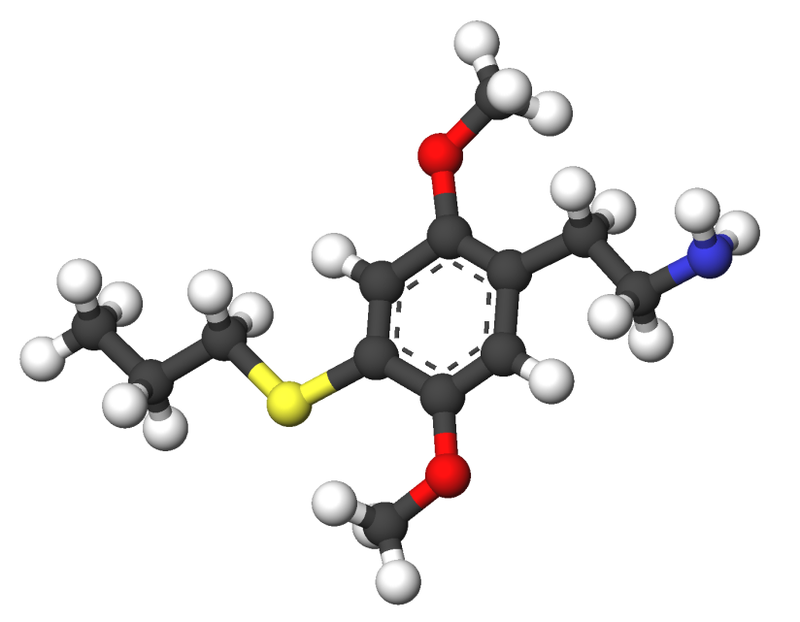Summary
2C-T-7, belonging to the psychedelic 2C family of phenethylamines, is highlighted in Alexander Shulgin’s book, “PiHKAL: A Chemical Love Story,” with a recommended dosage range of 10 to 30 mg. Typically administered orally, this compound elicits enduring psychedelic and entactogenic effects spanning 8 to 15 hours. It was commercially available in Dutch and Japanese smart shops and online until Operation Web Tryp resulted in three deaths, with two involving additional substances alongside 2C-T-7 and one linked to excessive insufflation. Street names for 2C-T-7 include “Blue Mystic” and “7th Heaven.” Despite its availability, research on this substance remains scarce, primarily relying on Shulgin’s insights in PiHKAL and a limited number of small animal studies primarily aimed at detecting metabolites.
| Identifiers | |
|---|---|
| CAS Number | 207740-26-9 [chemspider] |
| 3D model (JSmol) | Interactive image |
| ChEMBL | ChEMBL126432 |
| ChemSpider | 21106233 |
| PubChemCID | 24728635 |
| UNII | TJG366J9BA |

Pharmacology
The psychedelic and entactogenic effects of 2C-T-7 are likely brought about by its action as a 5-HT2A serotonin receptor agonist in the brain. This mechanism of action is a commonality shared with most known hallucinogenic tryptamines and phenethylamines.
Effects
2C-T-7 induces a psychedelic experience. Shulgin notes in PiHKAL that the hallucinations it produces are distinctive, and its use might lead to muscle tension and changes in vocal characteristics.

Deaths
The Partnership for a Drug-Free America claims that 2C-T-7 may have lethal effects even in small doses; however, their assertion lacks a cited source. Of the three documented deaths related to individuals using 2C-T-7, all cases involved either the ingestion of excessive insufflated doses or simultaneous consumption of other stimulants like ephedrine and MDMA. As of August 2007, there have been at least three reported deaths associated with 2C-T-7 use, often occurring at insufflated doses of 30 mg or higher or when combined with stimulants such as MDMA. Many instances of severe and distressing effects leading to hospitalizations were linked to the insufflation of 2C-T-7. In January 2002, Rolling Stone published an article titled “The New (legal) Killer Drug” about 2C-T-7. However, the legal status of the drug was inaccurately portrayed in the article, as 2C-T-7 may have already been illegal under the United States’ legally ambiguous analog act. A thorough response on the website Disinformation challenged the accuracy of much of the reporting in the Rolling Stone article. It’s important to note that all recorded fatalities involving individuals under the influence of 2C-T-7 took place when the individuals were known to be intoxicated with potentially life-threatening stimulants such as ephedrine or MDMA or after insufflating an excessive amount of 2C-T-7. The U.S. DEA classified the reported dose of 35 mg insufflated as “excessive.”
Legal status
Around the turn of the century, 2C-T-7 transitioned from relative obscurity to being used as a party and club drug in North America and Europe. It became accessible through several grey-market commercial vendors, attracting the attention of authorities. Consequently, many countries have scheduled this chemical.
Germany
2C-T-7 is a scheduled substance in Germany under the BTMG (Betäubungsmittelgesetz).
Australia
In Australia, both 2C-T-2 and 2C-T-7 fall under the country’s analogue drug laws.
Canada
As of October 31, 2016, 2C-T-7 is classified as a controlled substance (Schedule III) in Canada.
China
As of October 2015, 2C-T-7 is a controlled substance in China.
The Netherlands
The Netherlands was the first country to prohibit 2C-T-7, following a brief period of availability in smartshops. After 2C-T-2 was initially banned, 2C-T-7 quickly surfaced in the market but was soon banned as well. It is categorized as a List I drug under the Opium Law.
Sweden
In Sweden, 2C-T-7 is classified under Schedule I. It was first designated as a “health hazard” under the Act on the Prohibition of Certain Goods Dangerous to Health, effective April 1, 1999, according to SFS 1999:58. This designation rendered it illegal to sell or possess.
United Kingdom
In 1999, Alexander Shulgin received a copy of a letter from the British Home Office to several administrative associates, effectively categorizing all compounds listed in PiHKAL as Class A substances.
United States
On September 20, 2002, 2C-T-7 was temporarily classified as a Schedule I substance in the United States via an emergency ruling by the DEA. On March 18, 2004, the DEA published a Final Rule in the Federal Register, permanently placing 2C-T-7 in Schedule I (69 FR 12794).
FAQ
- What is 2C-T-7?2C-T-7 is a psychedelic phenethylamine from the 2C family of compounds. It’s known for its mind-altering effects and is sometimes used recreationally for its psychedelic properties.
- How is 2C-T-7 typically used?2C-T-7 is typically taken orally, and its effects can last from 8 to 15 hours. Users may ingest it in the form of a pill or powder.
- What are the effects of 2C-T-7?2C-T-7 produces psychedelic and entactogenic effects. Users may experience hallucinations, changes in perception, and an altered sense of self. It can also lead to muscle tension and an altered vocal quality.
- What is the mechanism of action of 2C-T-7?The exact mechanism of action isn’t fully established, but it’s believed to result from 2C-T-7 acting as a serotonin receptor agonist, primarily on the 5-HT2A receptors in the brain. This mechanism is shared by many other hallucinogenic substances.
- Is 2C-T-7 safe to use?The safety of using 2C-T-7 is a subject of debate. Some reports indicate that even small doses of 2C-T-7 can be lethal. However, many known cases of serious harm or death involve high doses, misuse, or combining it with other substances, such as stimulants like MDMA.
- Is 2C-T-7 legal?The legal status of 2C-T-7 varies by country. In some places, it is classified as a controlled substance, making its possession and distribution illegal.
- Is 2C-T-7 associated with any specific street names?Yes, 2C-T-7 is known by street names like “Blue Mystic” or “7th Heaven.” These names may vary by region.
- Can 2C-T-7 be addictive?There’s limited research on the addictive potential of 2C-T-7. However, it’s generally not considered physically addictive, but some users may develop psychological dependence.
- Are there any medical uses for 2C-T-7?2C-T-7 is not approved for any medical purposes and is primarily used recreationally or for self-exploration.
- What precautions should one take when using 2C-T-7?If you choose to use 2C-T-7, it’s essential to be cautious and use harm reduction practices. Ensure that you’re in a safe and controlled environment, use accurate dosing, and avoid combining it with other substances.
Notes
- Alexander Shulgin. “PIHKAL #43”.
- Kara Platoni. (May 1, 2002). “2C-T-7’s Bad Trip”. East Bay Express. “In 1999 it made its first commercial appearance in the Netherlands’ drug-dealing smart shops in both tablet and powder form. It was given the street name “Blue Mystic,” perhaps in order to differentiate it from its chemical cousin, another Shulgin creation named 2C-T-2.”
- Chris O’Connell (August 19, 2002). “A psychedelic summer”. Newsweek.
- WE Fantegrossi, AW Harrington, JR Eckler, S Arshad, RA Rabin, JC Winter, A Coop, KC Rice, JH Woods (September 2005). “Hallucinogen-like actions of 2,5-dimethoxy-4-(n)-propylthiophenethylamine (2C-T-7) in mice and rats” (PDF). Psychopharmacology. 181 (3): 496–503. doi:10.1007/s00213-005-0009-4.
- Alexander Shulgin (June 28, 2001). “2C-T-7”. Ask Dr. Shulgin. Centre for Cognitive Liberty and Ethics (COLE). Retrieved August 28, 2009.
- Partnership for a Drug-Free America. “2C-B, 2C-T-7”.
- B. Curtis. “Postmortem Identification and Quantitation of 2,5-Dimethoxy-4-n-propylthiophenethylamine Using GC-MSD and GC-NPD”. Journal of Analytical Toxicology 27.7 (2003): 493–98.
- Chris Platoni. “A psychedelic summer”. East Bay Express, May 1, 2002.
- “In the fall of 2000, a young healthy male died following snorting an excessive amount of 2C-T-7. Since this initial 2C-T-7-related death, two additional deaths reported in April 2001 have been linked to 2C-T-7. These two deaths resulted from the co-abuse of 2C-T-7 with MDMA.”
- “The New (Legal) Killer Drug”. Rolling Stone, January 10, 2002, issue 888: 44–49.
- 21 USC §813.
- Ken Lilly (2002). “The new (hip) drug hysteria: a journey into Rolling Stone’s abandonment of journalistic ethics.” Disinformation.
- Gazette, Government of Canada, Public Works and Government Services Canada, Public Services and Procurement Canada, Integrated Services Branch, Canada (May 4, 2016). “Canada Gazette – Regulations Amending the Food and Drug Regulations (Part J — 2C-phenethylamines)”.
- “关于印发《非药用类麻醉药品和精神药品列管办法》的通知” (in Chinese). China Food and Drug Administration, September 27, 2015.
- “Läkemedelsverkets författningssamling” (PDF).
- “Förordning (1999:58) om förbud mot vissa hälsofarliga varor – Karnov Open”.
- DEA. “Micgrogram Bulletin Jan 2004”.
- U.S. Department of Justice. “2C-T-7 Fast Facts” (PDF).
- “List of Schedule 1 drugs on the DEA Office of Diversion Control website”.